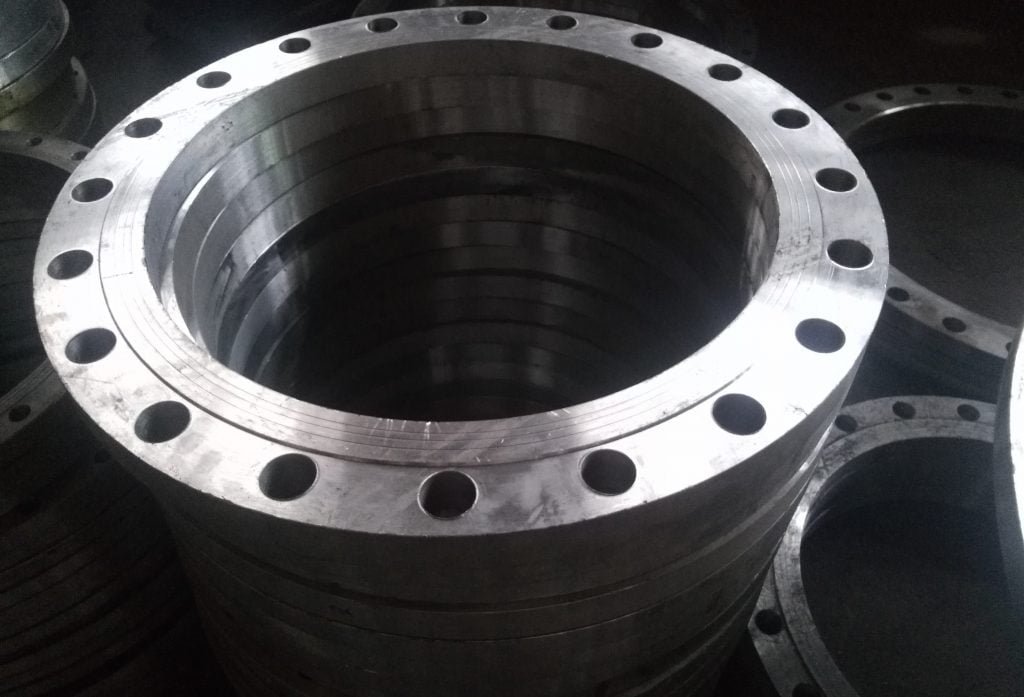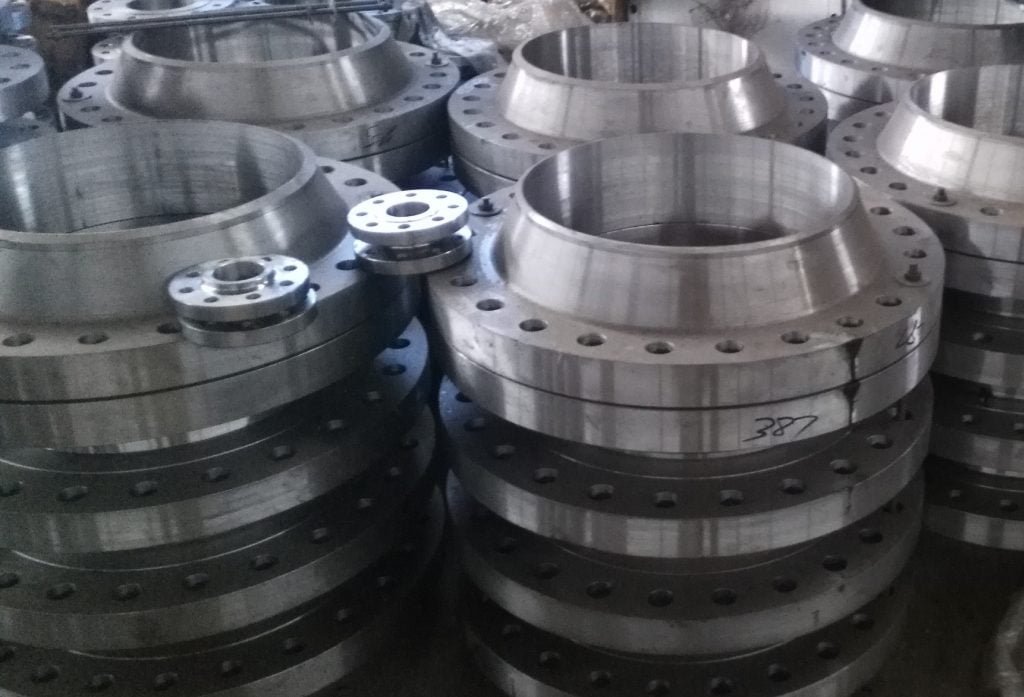large custom flanges
Large custom flanges are specialized flanges that are designed and manufactured to specific requirements that cannot be met by standard flanges. These flanges are typically used in industrial applications, such as oil and gas pipelines, chemical processing plants, and power generation facilities.



The key considerations for large custom flanges:
- Size: Large custom flanges can range in size from several inches to several feet in diameter. The size of the flange must be carefully determined based on the requirements of the application, taking into account factors such as flow rate, pressure, and temperature.
- Flange material: The material of the flange must be carefully selected based on the requirements of the application. Common materials used for large custom flanges include carbon steel flange, stainless steel flange, and alloy steel flanges such as Inconel or Hastelloy.
- Pressure rating: The pressure rating of the flange must be carefully determined based on the requirements of the application. This will determine the thickness of the flange and the number and size of the bolts required.
- Flange type: The type of flange must be carefully selected based on the requirements of the application. Common types of flanges include weld neck flanges, slip-on flanges, and blind flanges.
- Manufacturing process: Large custom flanges are typically manufactured using specialized processes such as forging or casting. The manufacturing process must be carefully selected based on the size and material of the flange, as well as the requirements of the application.
Overall, large custom flanges are a specialized product that requires careful consideration and expertise in design and manufacturing. It is important to work with a reputable manufacturer with experience in producing custom flanges to ensure that the product meets the specific requirements of the application.


What is the maximum size of the custom flange?
The maximum size of a custom flange can vary depending on the manufacturer, the material used, and the manufacturing process. Generally, custom flanges can be made in sizes ranging from a few inches to several feet in diameter. However, the maximum size of a custom flange is ultimately determined by the capabilities of the manufacturer and the specific requirements of the application.
For example, some flange manufacturers may specialize in producing large custom flanges for industrial applications, while others may focus on smaller custom flanges for specialized equipment or machinery. In addition, the material used to make the flange and the manufacturing process used can also impact the maximum size that can be produced.
When considering a custom flange, it is important to work with a reputable manufacturer who has experience in producing custom flanges of the size and material required for your specific application. The manufacturer can provide guidance on the maximum size that can be produced and help ensure that the flange meets the required specifications and standards.


What preparatory work is required for custom large flanges?
The preparatory work required for custom large flanges will vary depending on the specific requirements of the application and the manufacturer’s recommendations. Here are some of the key preparatory steps that may be required:
- Determine the size and specifications: The first step is to determine the required size, material, pressure rating, and other specifications for the custom large flange. This will help ensure that the flange is designed and manufactured to meet the specific requirements of the application.
- Provide accurate drawings and specifications: Accurate drawings and specifications are essential to ensuring that the custom flange is designed and manufactured correctly. The manufacturer may require detailed drawings, 3D models, or other information to ensure that the flange meets the required specifications.
- Material selection: The material used for the custom flange will depend on the requirements of the application. The manufacturer may require information about the fluid or gas being transported, the temperature and pressure conditions, and other factors to determine the appropriate material for the flange.
- Manufacturing process: The manufacturing process used to produce the custom flange will depend on the size, material, and other requirements. The manufacturer may provide recommendations on the best manufacturing process based on the specific requirements of the application.
- Quality assurance: Quality assurance is essential to ensuring that the custom flange meets the required specifications and standards. The manufacturer may perform various tests and inspections throughout the manufacturing process to ensure that the flange is of the highest quality.
Overall, the preparatory work required for custom large flanges will depend on the specific requirements of the application and the manufacturer’s recommendations. It is important to work with a reputable manufacturer who has experience in producing custom flanges to ensure that the flange meets the required specifications and standards.



Are there any hidden dangers in custom large flanges?
As with any engineering project, there may be potential dangers or risks associated with the design, manufacture, and installation of custom large flanges. Here are some of the potential risks or hidden dangers that could be associated with custom large flanges:
- Material selection: Choosing the wrong material for the flange could lead to corrosion, erosion, or other damage over time. It is important to carefully consider the properties of the material and the requirements of the application to ensure that the material is suitable for the intended use.
- Improper installation: Improper installation of the flange, including incorrect torque on the bolts or misalignment of the flange, could lead to leaks or other failures. It is important to follow the manufacturer’s recommendations for installation and to ensure that the flange is installed correctly. Want to know more, please click to view: How to install the pipe flange?
- Pressure or temperature issues: Custom large flanges are often used in high-pressure or high-temperature applications. If the flange is not designed or manufactured to withstand the required pressure or temperature, it could lead to failures or leaks.
- Welding or fabrication defects: If the custom flange is welded or fabricated incorrectly, it could lead to structural weaknesses or other defects that could compromise the integrity of the flange.
- Quality control issues: If the manufacturing process for the custom flange does not include adequate quality control measures, it could lead to defects or weaknesses in the finished product.
Overall, the potential risks or hidden dangers associated with custom large flanges can be minimized by working with a reputable manufacturer who has experience in producing custom flanges for the specific application. It is important to carefully consider the requirements of the application, including the material, pressure rating, and other factors, to ensure that the custom flange is designed and manufactured to meet the necessary specifications and standards.


How do we communicate with flange manufacturers when customizing large flanges?
When communicating with flange manufacturers to customize large flanges, it is important to provide clear and detailed specifications and requirements for the flange. Here are some tips on how to effectively communicate with flange manufacturers:
- Provide detailed specifications: Provide the manufacturer with as much detail as possible about the application, including the size and type of the pipe, the pressure and temperature requirements, the material specifications, and any other relevant information. This will help the manufacturer understand the requirements for the flange and ensure that it is designed and manufactured to meet those requirements.
- Ask questions: Don’t be afraid to ask questions if you are uncertain about any aspect of the design or manufacturing process. This will help ensure that you and the manufacturer are on the same page and that the final product will meet your needs.
- Discuss any customization needs: If you require any customization, such as drilling additional bolt holes or modifying the shape of the flange, discuss these needs with the manufacturer to ensure that they are able to accommodate them.
- Request design drawings: Ask the manufacturer to provide detailed design drawings or 3D models of the custom flange. This will help you visualize the final product and identify any potential issues or design flaws before the flange is manufactured.
- Confirm delivery and pricing: Confirm the delivery date and pricing for the custom flange before placing your order. This will help avoid any confusion or misunderstandings and ensure that you receive the flange when you need it.
By providing clear and detailed specifications, asking questions, discussing customization needs, requesting design drawings, and confirming delivery and pricing, you can effectively communicate with flange manufacturers when customizing large flanges.



How make custom large flanges have a higher success rate?
To improve the success rate of custom large flanges, there are several steps that can be taken:
- Work with an experienced manufacturer: Working with a manufacturer who has extensive experience in producing custom large flanges can help ensure that the flange is designed and manufactured to meet the necessary specifications and standards. Look for a manufacturer who has a proven track record of producing high-quality flanges for similar applications.
- Use advanced manufacturing processes: Advanced manufacturing processes, such as computer-aided design (CAD), finite element analysis (FEA), and 3D printing, can help ensure that the custom flange is designed and manufactured to precise specifications. These technologies can also help identify potential issues or weaknesses in the design before the flange is manufactured.
- Perform thorough testing and inspection: Thorough testing and inspection of the custom flange throughout the manufacturing process can help identify potential defects or weaknesses before the flange is installed. This can include pressure testing, x-ray inspection, ultrasonic testing, and other quality control measures.
- Use high-quality materials: Using high-quality materials that are suitable for the specific application can help ensure that the flange is able to withstand the required pressure, temperature, and other environmental factors.
- Follow proper installation procedures: Following the manufacturer’s recommended installation procedures, including proper bolt torque and alignment, can help ensure that the custom flange is installed correctly and will function as intended.
Overall, improving the success rate of custom large flanges requires careful attention to the design, manufacturing, and installation processes. By working with an experienced manufacturer, using advanced technologies, performing thorough testing and inspection, using high-quality materials, and following proper installation procedures, it is possible to increase the likelihood of a successful outcome.
If you want custom flanges from China, please check: How to Buy Chinese Flanges?
Lewis Liu
Hello, I am Lewis Liu, a professional sales engineer with over ten years of experience in the flange fittings industry. I am highly knowledgeable in flange selection, installation, and maintenance. I am passionate about providing customers with the best solutions to ensure their pipeline systems run smoothly, safely, and reliably.
If you have any questions or concerns regarding flange fittings for your pipelines, whether it’s about selection, material choice, specification requirements, or any other aspect, please feel free to contact me at any time. I am committed to offering professional advice and assistance to help you make informed decisions and meet your needs.
